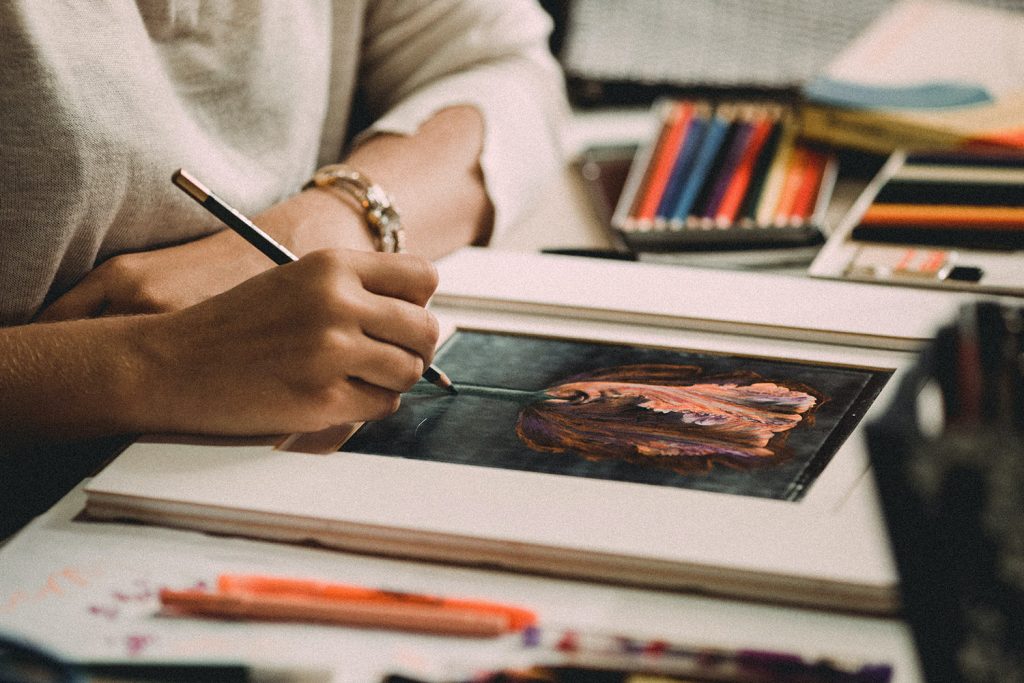In a world where artwork by female artists makes up just 3–5% of major permanent collections in the US and Europe, it is important for institutions to foreground women in the industry. One such initiative is ING’s annual Discerning Eye exhibition, which offers a platform for new and established practitioners across the creative disciplines. Fashion designer and artist Sadie Clayton, one of 2018’s selectors, discusses her role; the intersection of art, fashion and technology; and the importance of ING’s initiative for emerging talent.
A: What drew you to become an ING Discerning Eye exhibition selector?
SC: The premise of the exhibition is unique, refreshing and diverse. The cross functional nature of my chosen works and the breadth of background of the selectors sat very well with my own personal creativity. The fact that I was, to an extent, able to give back to the world which has supported me as an emerging artist and designer for so long was a joy. My promise to myself was that when I had the possibility to champion others as I have been in the past, I would, and this is hopefully just the first step in the right direction.
A: What was the turning point in your career? Was there a breakthrough moment when you started to get a lot of publicity?
SC: Though I had done several fashion shows in London, Berlin and Shanghai as a designer, my first real exhibit of my own work was at Art Basel Miami. I had three mannequins, prime location in the entrance of a huge exhibition hall together with a stand of my works within the show, and it felt immense. Tens of thousands of people saw my work across the weekend, took selfies with the mannequins and interacted with my pieces.
A: All the artwork in ING Discerning Eye has been selected for exhibit, how did it feel when you first exhibited and what did it mean for your career?
SC: It was nerve racking, exciting and very special to be one of the first fashion designers to exhibit as part of the event.
A: Who or what was your biggest influence in your career?
SC: This may sound strange, but the biggest influence in my career hasn’t come from the outside. Naturally I am hugely stimulated by different artists, architects and fashion designers – Thierry Mugler, Martin Margiela, the artistic work of Anish Kapoor, Rachel Whiteread, Joan Miro or Barbara Hepworth and the inimitable Zaha Hadid, but it has been my family who have given me the support and confidence to be who I am, follow my energy and positivity, and embrace being a fusion of artist, designer and creator.
A: Is there still an influential person such as a mentor or sponsor?
SC: I try to surround myself with people who inspire me and from whom I can learn. I have been lucky enough to meet some amazing people who have reached the top of their careers along the way. Whilst I don’t have one specific mentor, I have people who I deeply respect such as Carolyn Franklin, Ron Arad and my amazing business partner who gives me advice and direction.
A: How do the worlds of art, technology and fashion complement each other and how do you explore this in your work?
SC: Today it is impossible to draw boundaries around creativity, where it comes from, how it is expressed and how it is then enjoyed and interpreted by others. I have always seen myself as a forward-looking designer and have been fascinated by how technology enables my pieces to take on another dimension and bridge the divide between fashion and art. I consider my copper sculptures and even my collections to be art for the body, enabling owners to make them come alive and interpret them as they choose. It is completely subjective, and our views or interpretation of a piece depends on our personality and experiences.
I did one exhibition which really harnessed this concept at the Royal Academy of Arts in 2016. It was called Ownership, and it fused the technology of the holographic form – which makes a solid, material object take on a fluid form – with the idea of possession, which was defined as the immaterial passion to own a material object. It explored how fashion can also be created, collected and sold as a work of art. It was a huge success and a perfect example of the way I see the three themes as distinct but intertwined.
A: Why did you start experimenting with different materials?
SC: From the start, even before I had any formal training, I was fascinated by working not only with fabrics but with other materials including metals and crystals. I especially enjoy working with copper, which up until now has been my favourite medium. I love the way that I can create a sculpture with a three-dimensional form that takes on its own life when the light hits it in different ways. It is always surprising and changing.
A: How do you pick your collaborative partners?
SC: I am naturally drawn to partners who have a similar aesthetic sensibility or artistic heritage. Partners, whether individuals or brands, have always been people who are brave enough to see the beauty in our artistic past, but embrace change and the art of design.
A: All the artwork in ING Discerning Eye is available to buy, what was the first piece of art you bought?
SC: I bought a coat with Joan Miro art on the back, I was a student and it was my pride and joy, all £30 of it! Since then I have gone on to own a couple of Philippe Starck chairs, couple of Matisse prints and an incredible Issey Miyake pleats please jacket, all this creativity is art to me. I felt happy and amazing when wearing the pieces and love to see the chairs in my home. One I use as a plant stand so nobody can sit on it!
A: What’s your top tip for art collectors?
SC: If you feel the energy between yourself and the piece… BUY IT!!
ING Discerning Eye, an exhibition of small works selected by prominent figures in the art world, is currently calling for entries. Pre-register by 28 August 2018, 5pm here or at your chosen submission point. The exhibition will run from 15-25 November 2018 at Mall Galleries, London.
Credits:
1. Sadie Clayton. Film still from studio in Dalston, May 2017. Courtesy the Adobe team and casual films.




